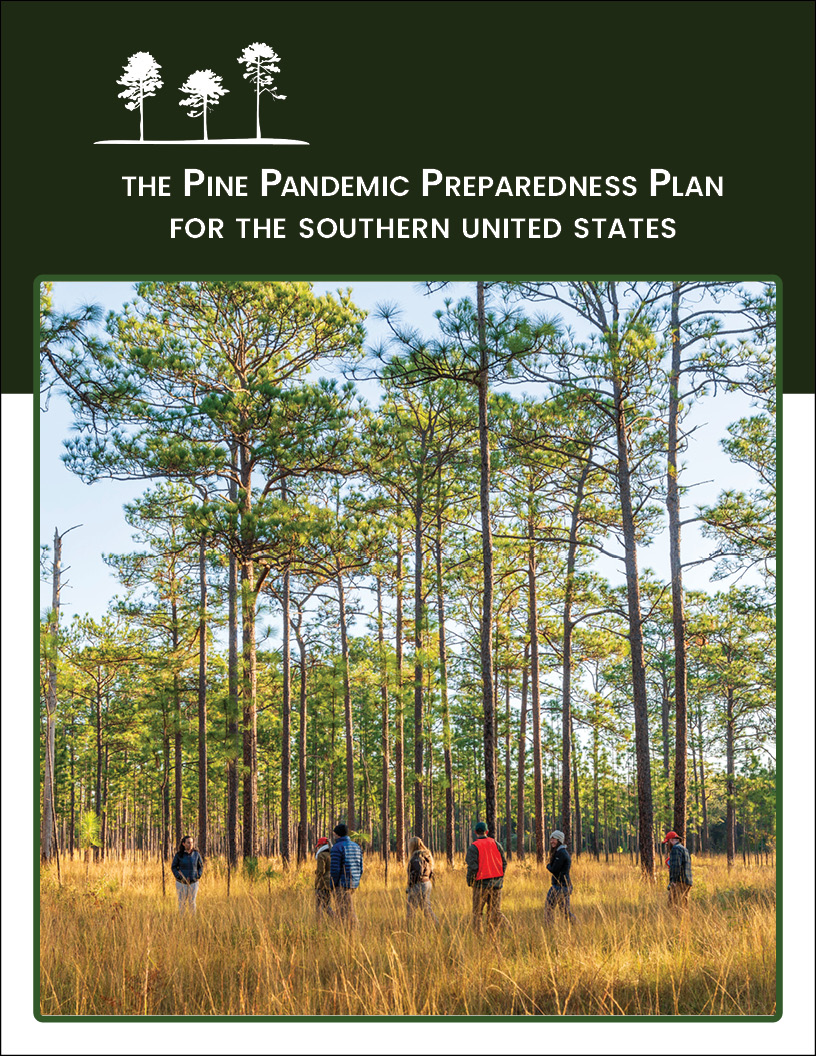Southern U.S. pines:
- Represent 61% of U.S. planted forest area and 57% of U.S. wood volume.
- Provide $230 billion in value and over 1 million jobs.
- Comprise working forests which provide carbon sequestration, wildlife habitat, biodiversity, soil protection, and improved air and water quality.
- Are vulnerable to high-impact pests and diseases spreading rapidly and causing extensive economic, ecological, cultural, and ecosystem service impacts.
The P4 outlines the steps needed to recognize and stop outbreaks of currently unknown new invasive pests or diseases causing significant injury to pine trees throughout the southern U.S. In this plan, invasives are pests or diseases that cause ecological or economic harm to forests in a new environment, i.e., where they are not native. This plan was co-developed by a group of stakeholders with interests in protecting, managing, and conserving pine resources including private landowners, foresters, forest product and investment companies, universities, and state and federal agencies in the South. Implementation of the P4 will allow forest health specialists and scientists to work with extension agents, land managers, and landowners to address emerging invasive pests and diseases rapidly and efficiently. The four central points of the plan to be implemented are:
I. COMMUNICATION PLAN
This plan starts by building on existing stakeholder communications networks. Because communication is key to coordination of activities to identify and control emerging invasives as quickly and efficiently as possible, the P4 will establish a communications network to:
- Immediately report any potential threat to southern pines to forest health specialists in state, federal, or academic units to prevent uncontrolled spread.
- Continue communication between landowners, managers, and others.
Basics of the Plan
Definitions
- Insect: an organism with six legs, an external skeleton with three body parts, and two antennae.
- Disease: any condition in a plant caused by any living organism (a pathogen, including any fungus, bacterium, or virus) that interferes with the normal growth and development of any plant.
- Forestry First Responder: a professional in the field of forestry who may routinely encounter pests and pathogens of trees before they have been diagnosed or treated.
- Invasive species: any organism that causes ecological or economic harm to any plant in a new environment where it is not native.
- Pathogen: any organism that causes a disease in another living organism.
- Pest: any living organism, other than a vertebrate animal, in any stage of its existence, which is injurious or likely to be injurious to any plant.
Goals
- This plan helps to highlight numerous resources that are already in place and more that might be needed to protect southern pines.
- The plan also articulates roles for diverse organizations to act more strategically within their current capacities to prevent a widespread outbreak by a new pest or disease.
- The plan provides a foundation for forest health specialists and scientists to communicate and collaborate with political, social, and economic scientists to address any emerging high impact non-native pest or disease efficiently and rapidly.
- This plan will be useful to decision makers seeking to better understand the resources needed for adequate biosecurity for a vital economic sector. While it is focused on the southern pine resource, P4 is potentially exportable to other regions as needed.
- At this point, the P4 is a guideline on how best to deal with an invasive high-impact species on pines; It is not yet at the implementation stage. However, as a group, we have provided major recommendations to allow the stakeholders to eventually marshal the resources necessary for the P4 to become live and to be implemented across the region. Such a collaborative effort would allow us to be truly proactive and to stop the invasions before they become a threat to our southern pine resources.
Main phases of the plan
- Communication
- Detection and diagnosis
- Delimitation and assessment
- Response

